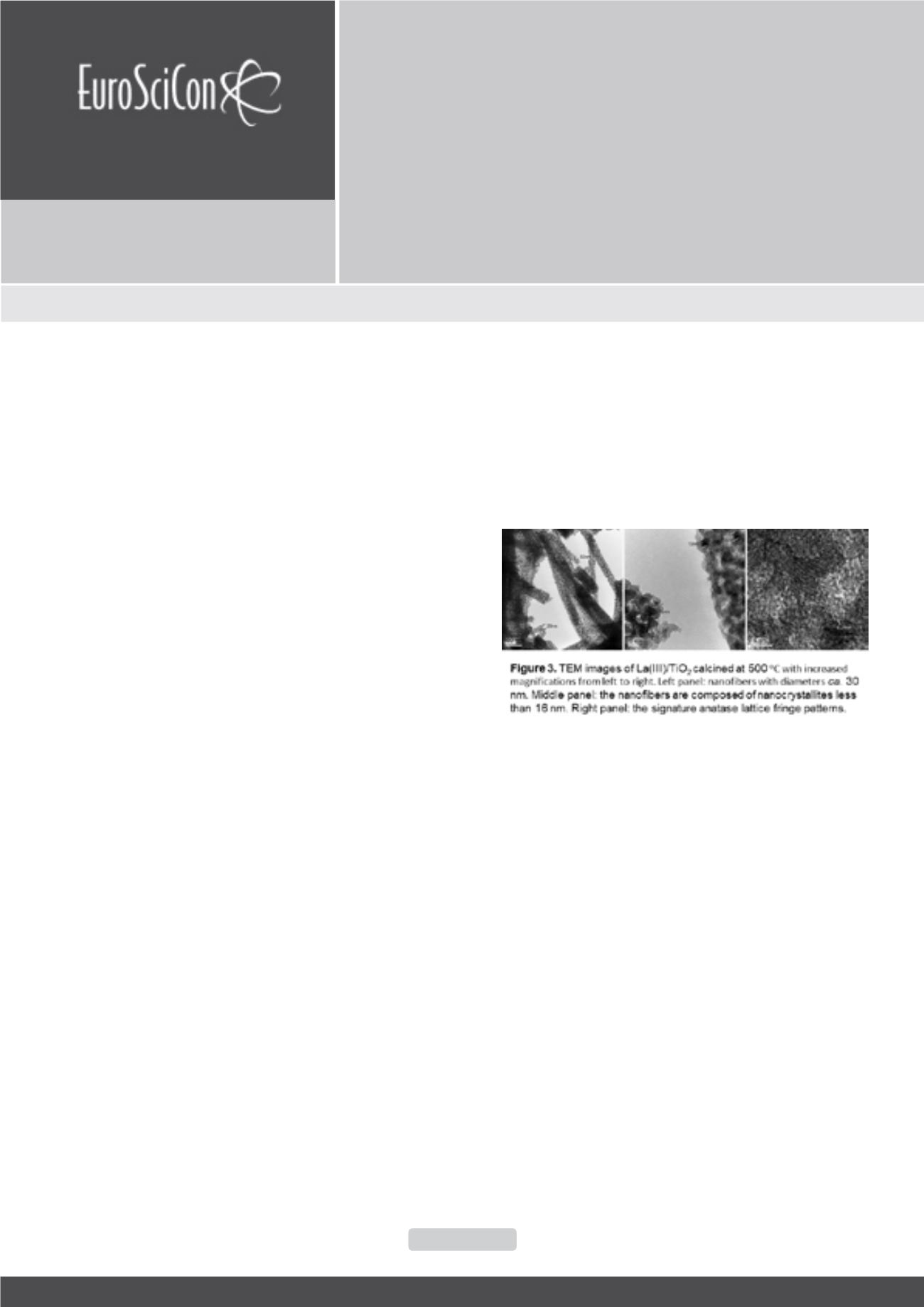

NanoMat 2018
Nano Research & Applications
ISSN: 2471-9838
Page 23
April 26-27, 2018
Rome, Italy
17
th
Edition of International Conference on
Emerging Trends in
Materials Science and
Nanotechnology
M
odified Titania is of great interest for industrial catalysts
and photocatalysts with applications in environmental
engineering. In this research, La(III) was incorporated into
titanium oxoacetate complexes via a one pot sol-gel process
of metal alkoxides reacting with acetic acid, evidenced by
electrospray ionization mass spectrometry analysis. The
resulting well-defined nanofibers were calcined to obtain
1-dimensional La-doped TiO
2
materials. For comparison,
lanthanumwas also deposited on the surface of TiO
2
nanofibers
by an impregnation method. X-ray photoelectron spectroscopy
analysis shows that the oxygen defect in the La-doped sample
was more significant than that in the La-deposited TiO
2
. In
addition, more interaction of lanthanumwith theTiO
2
matrixwas
observed in the nanofibers synthesized via the sol-gel method.
These features of doped TiO
2
nanofibers are anticipated to
play a role in higher catalytic activity. In addition, both the La-
doped and deposited TiO
2
nanofibrous materials exhibited
excellent thermal stability. The N
2
-physisorption and powder
x-ray diffraction characterizations show that both anatase
crystallites and surface areas in the lanthanum-modified TiO
2
were maintained better than the unmodified counterparts at
temperatures up to 900°C. As a cleaner energy resource, natural
gas provides about 30% energy consumption and more than
27% electricity generation in North America. However, many
natural gas reservoirs contain H
2
S, which needs to be removed
by amine scrubbing followed by a Claus process. With pending
stricter emission policies and lower commodity prices, it is
urgent for natural gas producers to seek more efficient Claus
catalysts. In this context, lanthanum-modified TiO
2
was tested
as a Claus catalyst and a better performance was observed
than the unmodified TiO
2
. We attributed the promoted catalytic
activity of La-modified TiO
2
to the M
3+
cations, which causes
oxygen defects in TiO
2
and thereby increases SO
2
adsorption
capacity. A higher SO
2
adsorption on the catalytic surface
enhances both H
2
S and CS
2
conversion. In addition, sulfate
concentrations in the used catalysts were studied to explain
the catalytic activities.
Recent Publications
1. Sui R, Marriott R, et al. (2017) Organo sulfur adsorbents
by self-assembly of titania based ternary metal oxide
nanofibers. Journal of Materials Chemistry 5:9561-
9571.
2. Sui R, Marriott R, et al. (2016) Selective adsorption of
thiols using gold nanoparticles supported on metal
oxides. Langmuir 32:9197-9205.
3. Clark P, Sui R, et al. (2013) Oxidation of CO in the
presence of SO
2
using gold supported on La
2
O
3
/TiO
2
nanofibers. Catalysis Today 207:212-219.
4. Sui R and Charpentier P (2012) Synthesis of metal
oxide nanostructures by direct sol–gel chemistry
in supercritical fluids. Chemical Reviews 112:3057-
3082.
5. Sui R, Berlinguette C, et al. (2008) Simple protocol
for generating TiO
2
nanofibers in organic media.
Chemistry of Materials 20:7022-7030
Biography
Ruohong Sui has his expertise in making metal oxide nanomaterials using a
sol-gel process. He is interested in self-assembly of metal-ligand complexes
to make 1- and 2-dimensional nanomaterials in non-aqueous media, and
using the resulting materials for clean energy applications.
rsui@ucalgary.caBimetallic acetate complexes derived La(III)-doped TiO
2
nanofibers for Claus catalysts
Ruohong Sui, Christopher B Lavery, Nancy Chou
and
Robert A Marriott
University of Calgary, Canada
Ruohong Sui et al., Nano Res Appl, Volume:4
DOI: 10.21767/2471-9838-C1-008
















